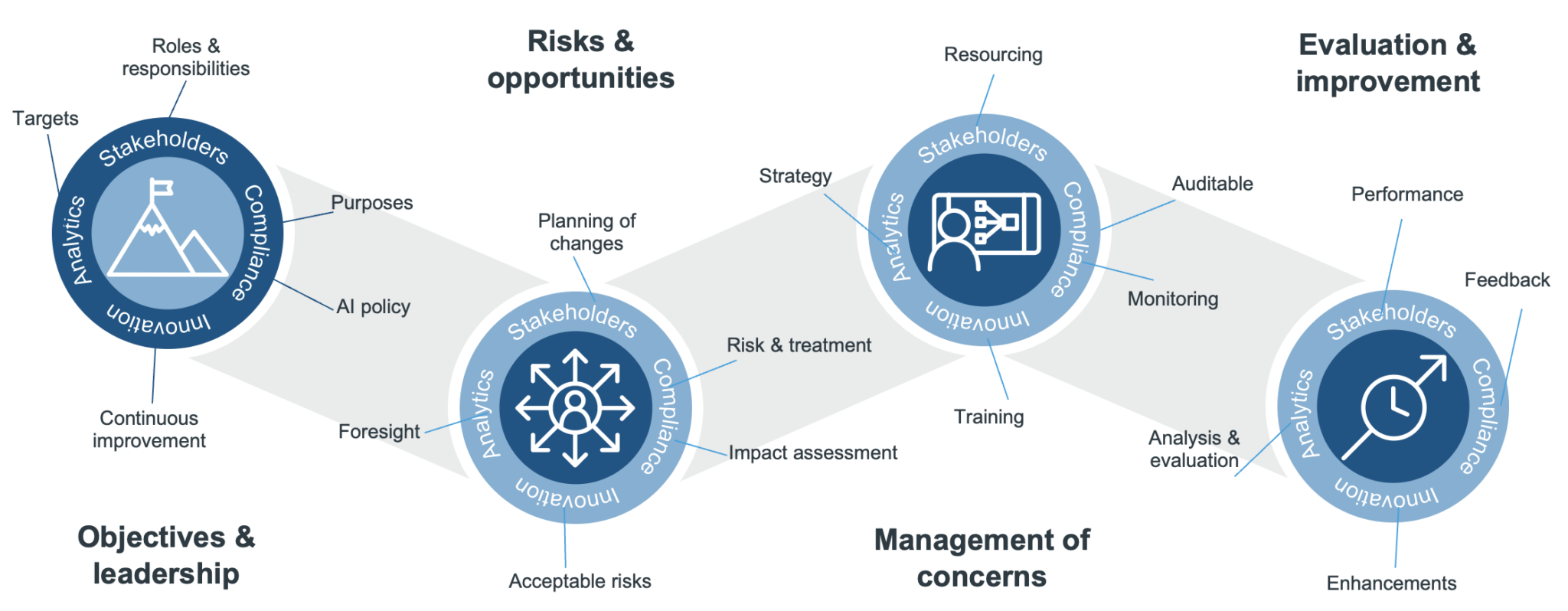Secure your platforms and products to drive insights from AI and accelerate healthcare transformation.
The rapid evolution of artificial intelligence (AI) and emerging regulations has created the demand for robust frameworks and standards to ensure AI’s responsible and effective deployment. To achieve this, integrating guidance for AI with standards and frameworks is needed to manage risks, align with regulations, and enhance trust in AI systems. This will facilitate readiness assessments, options analyses, and feature design for defensible AI.
Two key tools stand out in this landscape: ISO/IEC 42001 AI Management System and the NIST AI Risk Management Framework. Together, these tools provide comprehensive guidance for integrating AI into organizational practices while maintaining a strong focus on risk management, continuous improvement, and ethical considerations.
The Big Picture
ISO/IEC 42001 AI Management System offers an overarching quality management approach to AI, encompassing organizational objectives, leadership, risk assessment, and continuous improvement. This standard serves as a gateway to numerous other AI standards, published or under development, providing a holistic view of AI systems.
Key components of ISO/IEC 42001 include:
- Organizational objectives & leadership: aligning AI initiatives with organizational goals and ensuring leadership commitment.
- Risk & opportunities management: identifying and treating risks while capitalizing on opportunities.
- Management of concerns: addressing stakeholder concerns and ensuring transparent communication.
- Evaluation & improvement: implementing continuous monitoring, analysis, and evaluation to enhance the AI system over time.

This standard emphasizes the importance of risk assessment and treatment, impact assessments, and the need for ongoing evaluation and improvement. It underscores the necessity for a structured approach to managing AI within an organization, ensuring that AI systems are effective and also defensible. As an international standard, it also provides a path to conformance with best practices.
The Deep Dive
The NIST AI Risk Management Framework, while similar to ISO/IEC 42001 without a formal conformance option, is valuable for developing policies and treatment options. It is comprehensive, covering the standard NIST approach of mapping, measuring, and managing risk with a core component of governance that cuts across all activities. As with many NIST frameworks, it is likely to become a benchmark for evaluating maturity.
Key elements of the NIST framework include:
- Map: identifying AI systems, their contexts, and associated risks.
- Measure: evaluating AI system risks and their impact.
- Manage: establishing resources to monitor and deal with risks.
- Govern: implementing core policies to ensure trustworthy AI.
The NIST framework also offers an online playbook with suggested actions, transparency practices, documentation, and references , making it practical for organizations to adopt and tailor to their specific needs. Its alignment with the OECD framework for the classification of AI systems, providing a policy tool to evaluate risks to people and the environment in specific operating contexts, further enhances its utility.
A Unified Approach
AI and privacy are entangled, inspiring integrated solutions for data protection and AI governance when information about people is at stake. Enhanced data protection, scalable AI governance, and robust infrastructure are critical for improving decision-making accuracy and reliability. AI governance extends into areas such as data governance, data architecture and quality management, data modeling and ontologies, to name a few. It also incorporates IT practices like ethical hacking, vulnerability assessments, and penetration testing.
As AI governance continues to evolve, the need for structured frameworks and standards is becoming increasingly important. The ISO/IEC 42001 AI Management System and the NIST AI Risk Management Framework provide comprehensive guidance to ensure responsible and defensible AI deployments. By integrating these standards into data governance practices and robust data infrastructure, organizations can enhance data protection, scalability, and decision-making accuracy.
The future of AI governance lies in continuous improvement, ethical considerations, and the seamless integration of AI and privacy solutions. Contact us when you want to learn more and see how our advisory or consulting services can help you drive trustworthy insights at scale.
Related solutions
Insights are trapped in mountains of text. NLP sets them free.
Extract, structure, normalize, de-identify and transform your disparate data sources into analytics-ready output.

























